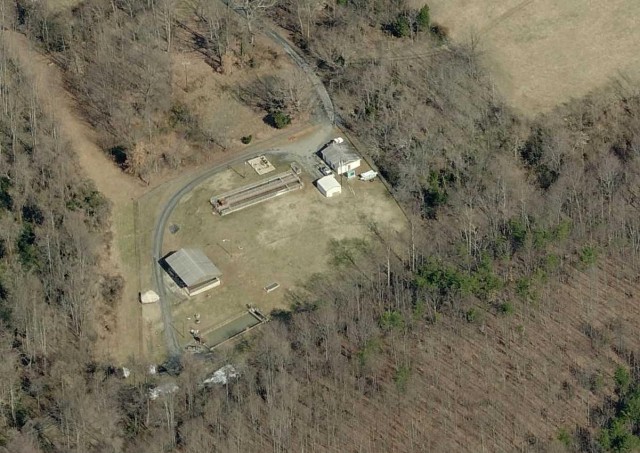NORFOLK - Buckingham County needed a hand.
A waste water treatment plant in one of its towns, Dillwyn, required expansion, so county officials approached the U.S. Army Corps of Engineers, Norfolk District with a request: help us complete the design and construction of the expansion.
Norfolk District, which provides assistance with water-related environmental infrastructure projects, responded with a project delivery team to meet the goals of the Dillwyn WWTP expansion: improve the quality of treated material released from the facility and provide additional storage capacity. The extra storage would contain the large volume of waste water produced during significant rain storms - peak flows as high as 150,000 gallons per day - eliminating instances when untreated sewage is released into the Chesapeake Bay watershed.
"One significant way to restore the living resources of the Chesapeake Bay, such as oysters, blue crabs and submerged aquatic vegetation, is to improve water quality through the reduction of dissolved nutrients entering the watershed," said Janet Cote, team member and marine biologist with Norfolk District. "Expanding the WWTP will result in improved water quality of the James River by removing dissolved nutrients and sediment, which will ultimately improve the health of the Chesapeake Bay."
The Dillwyn WWTP serves the local town, the areas near the intersection of Routes 15 and 20, the industrial park, the high school and the middle school. The Dillwyn WWTP is currently permitted for 100,000 gallons per day and discharges a monthly average between 60,000 and 65,000 GPD. During rain, the plant has experienced peak flows as high as 150,000 gallons per day. After waste water is treated, the material is released into an unnamed tributary of Whispering Creek in the James River Basin, according to Buckingham County officials.
"Monitoring has shown that progress has been made in reducing the amount of phosphorus entering the Chesapeake Bay from nonpoint and municipal point sources, but work still needs to be done to reduce the amount of nitrogen and sediment loading released into the watershed," Cote said.
Overflows from combined sewers pose a serious threat to the James River, project planners said. During high water events, storm water creates high flows that are too great to be processed by the WWTP and excess flows run untreated into the river, carrying large quantities of raw sewage. During large rainfall events, some WWTPs contribute more fecal bacteria than from all other combined sources on the river. These large storm overflows also force the closure of oyster beds in the lower estuary segments to prevent fecal contamination.
Currently, nine tributaries to the James River, located in Albemarle and Buckingham counties, have impaired waters due to bacteriological contamination. If left unchecked, said district planners, these waters will fail to meet the minimum required Total Maximum Daily Load to sustain water quality, as prescribed by the nation's Clean Water Act. The expansion project will also help to achieve sustainable nutrient reduction goals.
Buckingham County sponsored the study, finalized in December 2009, which evaluated the expansion and upgrade of the Dillwyn WWTP. The upgrades recommended in the study included several retrofits, construction of structures and implementation of new technologies.
District project planners said the expansion will include the installation of sequencing batch reactors with tertiary filtration and an ultraviolet disinfection upgrade. The existing head works will be demolished and replaced with a new structure fitted with new grinding and screening equipment to protect downstream equipment and improve the quality of treated material. A second equalization tank will be constructed to meet the capacity requirements for the 200,000 gallons per day facility. Additionally, a new influent flow meter, in-plant pump station, automated solids dewatering system, fuel storage tank, and electrical control building will be built.
The improvements will provide nutrient removal capabilities necessary to meet new permit conditions, and provide an added barrier of regulatory compliance.
Over the years, the U.S. Army Corps of Engineers, Norfolk District, has partnered with counties like Buckingham, state and federal environmental agencies, and ecosystem-friendly civic groups to seek solutions and implement programs for restoring the health of the nation's largest estuary - the Chesapeake Bay.
Stretching across more than 64,000 square miles, the Chesapeake Bay watershed encompasses parts of six states along the U.S. East Coast. With its many tributaries, the Chesapeake Bay watershed endures an array of assaults from the air, water and land. Chemical contaminants, air pollution, landscape changes, erosion and over-harvesting of fish and shellfish also stress the Bay and its wildlife. The watershed's worst problem is nutrient pollution, which fuels the growth of algae blooms that degrade water quality and negatively impact aquatic life.
Under Section 510 of the Water Resources Development Act, Norfolk District is addressing the bay's habitat protection and restoration, sediment pollution cleanup, restoration of tidal and non-tidal wetlands and native oyster restoration. Dillwyn's water-related environmental infrastructure project fell within the scope of the WRDA.


Social Sharing